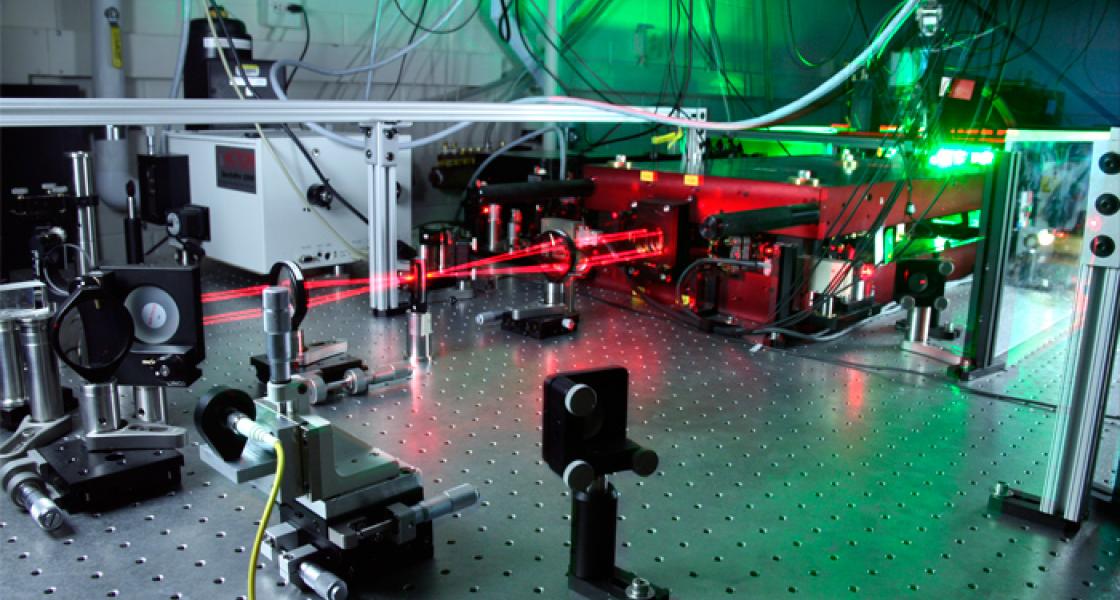Real-world quantum mechanics may not always work exactly like the simple picture presented in textbooks, according to observations made by research associate Gaël Nardin and his colleagues in the Cundiff group.
In a recent experiment (described online in Physical Review Letters this week), the group discovered evidence of coupling between particles in semiconductor quantum wells that hadn’t been predicted by simple textbook calculations. Semiconductors are materials whose electrical conductivity increases when light shines on them, and quantum wells are extremely thin layers of semiconductor materials. These layers are so thin that tiny particles in them exist as waves and their behavior is dominated by quantum mechanics. Consequently, quantum wells are ideal for studying the strange properties of quantum physics, including some unexpected particle couplings.
The coupled particles studied by Nardin and his colleagues were excitons, which are hydrogen-like quasi particles consisting of negatively charged electrons bound to positively charged “holes” in semiconductors. Holes are like bubbles created when electrons are excited by light. Excited electrons and holes then pair together to form excitons when laser light interacts with quantum wells.
The researchers created excitons in two adjacent quantum wells, one wide and the other narrow. Then they probed the interactions of the excitons with a precision optical instrument called the JILA MONSTR (Multidimensional Optical Nonlinear SpecTRometer). The research team included Nardin, newly minted Ph.D. Galan Moody, graduate students Rohan Singh and Travis Autry, former research associate Hebin Li, Fellow Steve Cundiff, and François Morier-Genoud of Switzerland’s École Polytechnique Fédérale de Lausanne.
The researchers expected to see what the textbooks predicted: coupling between the two quantum wells due to the wave-like nature of the electrons and holes in the wells. Because they are waves, the electrons and holes can tunnel through the barrier between the wells; in contrast, if they were governed by classical physics they would have had to jump over it.
At first, the experiment confirmed the presence of coupling between the narrow and the wide quantum wells. For example, a coupling peak appears clearly in the two-dimensional measurement produced by the JILA MONSTR, shown in the figure. However, a careful analysis of the experimental results revealed that the coupling had not originated from textbook quantum coupling, but rather from the collective interaction of multiple excitons in both quantum wells. This exciting finding implies that scientists should plan on including the interactions of many particles to reproduce what Mother Nature is actually doing in the quantum world.
The new picture of coupling between quantum wells may help scientists better understand light harvesting in plants and bacteria. In light harvesting, energy is transferred between pigments that can be modeled as quantum wells because electrons can hop from one pigment to another. This behavior is similar to what Nardin and his colleagues observed with excitons in their coupling experiment.
The Cundiff group’s fundamental research into real-world quantum coupling of many particles also promises to facilitate applied research such as the enhancement of quantum cascade lasers, which employ multiple adjacent quantum wells to produce lasing.—Julie Phillips



 The Physics Frontiers Centers (PFC) program supports university-based centers and institutes where the collective efforts of a larger group of individuals can enable transformational advances in the most promising research areas. The program is designed to foster major breakthroughs at the intellectual frontiers of physics by providing needed resources such as combinations of talents, skills, disciplines, and/or specialized infrastructure, not usually available to individual investigators or small groups, in an environment in which the collective efforts of the larger group can be shown to be seminal to promoting significant progress in the science and the education of students. PFCs also include creative, substantive activities aimed at enhancing education, broadening participation of traditionally underrepresented groups, and outreach to the scientific community and general public.
The Physics Frontiers Centers (PFC) program supports university-based centers and institutes where the collective efforts of a larger group of individuals can enable transformational advances in the most promising research areas. The program is designed to foster major breakthroughs at the intellectual frontiers of physics by providing needed resources such as combinations of talents, skills, disciplines, and/or specialized infrastructure, not usually available to individual investigators or small groups, in an environment in which the collective efforts of the larger group can be shown to be seminal to promoting significant progress in the science and the education of students. PFCs also include creative, substantive activities aimed at enhancing education, broadening participation of traditionally underrepresented groups, and outreach to the scientific community and general public.